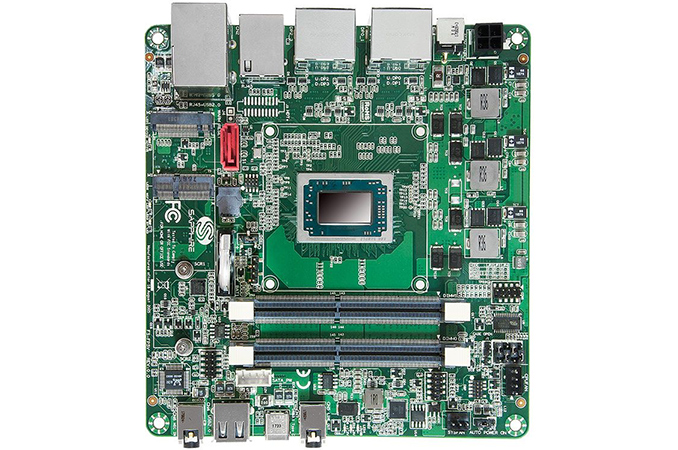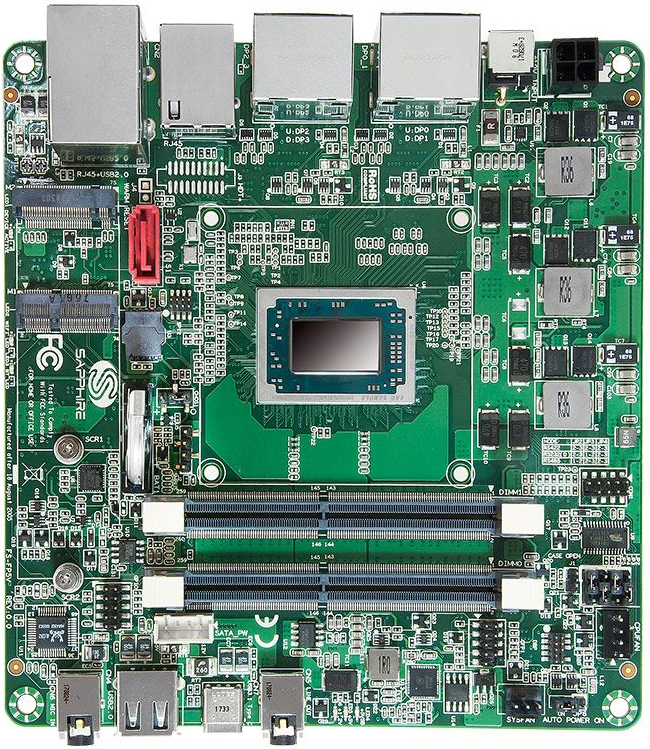Sapphire Unveils FS-FP5V: AMD Ryzen Embedded Mini-STX Motherboard
by Anton Shilov on July 9, 2018 10:00 AM EST- Posted in
- Motherboards
- AMD
- Sapphire
- Ryzen Embedded
- FP5V

Sapphire has announced one of the world’s first platforms based on AMD’s Ryzen Embedded V1000-series APUs. The motherboard is aimed at various embedded applications that can take advantage of AMD’s latest Zen and Vega architectures and their capabilities. The FS-FP5V also happens to be the industry’s first Mini-STX motherboards to feature AMD’s processor.
The Sapphire FP5V is based on AMD’s Ryzen Embedded V1000 APU featuring two or four cores with SMT clocked at 2 – 3.35 GHz base frequency, AMD’s Radeon Vega 3/8/11 iGPU, a dual-channel memory controller, and so on. Depending on requirements for performance and price, the Ryzen Embedded SoCs can feature a 12 – 25 or a 35 – 54 W TDP. AMD introduced its Ryzen Embedded chips earlier this year and will continue to sell them throughout 2028, giving adopters plenty of time to build and sell their products.
The motherboard is outfitted with two DDR4 SO-DIMMs supporting up to 32 GB of DDR4-2400 – DDR4-3200 memory, a SATA connector, an M.2-2280 slot (PCIe 3.0 x4 or SATA) for SSD, an M.2-2242 slot for a Wi-Fi module, two GbE ports (enabled by Realtek’s RTL8111G controllers), a quad-channel audio controller (ALC262), three USB 2.0 headers, one USB 3.1 Type-C connector, one RS232/422/485 module, etc. See precise specs in the table below.
The key features of Sapphire’s FP5V are of course up to four high-performance Ryzen CPU cores, AMD’s Radeon Vega iGPU with up to 704 stream processors as well as rich connectivity capabilities (e.g., four display outputs). The list of embedded applications that may require such embedded SoCs. include various gaming machines, digital signage, thin clients, medical imaging, and so on.
Sapphire’s FP5V is available for order from the company’s web site. Pricing depends on exact configurations as well as volumes.
| Sapphire's Mini-STX Motherboard with Ryzen Embedded V1000 APUs | ||
| FP5V | ||
| APU (Soldered Down) |
Ryzen Embedded V1202B: 2C/4T, 2 - 3.6 GHz, Vega 3, 12 - 25W Ryzen Embedded V1605B: 4C/8T, 2.06 - 3.6 GHz, Vega 8, 12 - 25W Ryzen Embedded V1756B: 4C/8T, 3.25 - 3.6 GHz, Vega 8, 35 - 54W Ryzen Embedded V1807B: 4C/8T, 3.35 - 3.8 GHz, Vega 11, 35 - 54W |
|
| Graphics | Ryzen Embedded V1202B: Radeon Vega 3 with 192 SPs at 1100 MHz Ryzen Embedded V1605B: Radeon Vega 8 with 512 SPs at 1100 MHz Ryzen Embedded V1756B: Radeon Vega 8 with 512 SPs at 1100 MHz Ryzen Embedded V1807B: Radeon Vega 11 with 704 SPs at 1300 MHz |
|
| Display Outputs | 4 × DisplayPort 1.4 | |
| Memory | 2 × DDR4 SO-DIMM slots for up to 32 GB of DDR4 SDRAM Ryzen Embedded V1202B: up to DDR4-2400 Ryzen Embedded V1605B: up to DDR4-2400 Ryzen Embedded V1756B: up to DDR4-3200 Ryzen Embedded V1807B: up to DDR4-3200 |
|
| Ethernet | 2 × Realtek RTL8111G controllers | |
| Storage | 1 × SATA 6 Gbps 1 × M.2 (PCIe 3.0 x4 or SATA) |
|
| Audio | Realtek ALC262 4-channel audio |
|
| USB | 4 × USB 2.0 Type-A 1 × USB 3.1 Type-C |
|
| Serial Port | 1 × RS232/422/485 header | |
| Wi-Fi | M.2-2242 slot | |
| Operating Temperature | 0°C~50°C (32°F~122°F) | |
| Form-Factor | Mini-STX (147.3 mm × 139.7 mm | 5.8" × 5.5") | |
Related Reading:
- ASRock at CES 2018: Micro-STX DeskMini GTX PC Gets Coffee Lake
- SilverStone Introduces VT01 Mini-STX Chassis for $35
- ASRock DeskMini 110 mini-STX PC Review
- MSI Cubi 2 Plus vPro Skylake mini-STX PC Review
- ECS LIVA One Skylake mini-PC Review
Source: Sapphire (via Tom’s Hardware)













28 Comments
View All Comments
PeachNCream - Monday, July 9, 2018 - link
The STX form factor is a great place for Ryzen, but I'm guessing the price is going to be rather high since this is an embedded board. Consumer availability might be rather iffy too, but it's a step in the right direction.Xajel - Tuesday, July 10, 2018 - link
The top of range version cost about $450, of course you still need RAM, storage and so on.Sergio526 - Monday, July 9, 2018 - link
Would have liked to see HDMI and CIR, would have been a nice alternative for NUCs in the HTPC arena. The 3.5mm jacks on the front are... confusing. Is one for headphones and the other for a microphone instead of a combo? If so, why are they on either side of the USB ports instead of right next to each other? Also, where's the fourth USB Type A port?PeachNCream - Monday, July 9, 2018 - link
The audio jack on the far left of the bottom image appears to have the word "MIC" next to it. My old SunRay thin client and a number of other older models featured front 3.5mm audio jacks for headphones and microphones. Since this is an embedded board, I'm betting that thin client use is one of the intended targets, though it seems like quite a bit of CPU and GPU grunt for such a system.Sergio526 - Monday, July 9, 2018 - link
You're right, it does say MIC and other says Line Out. Still really weird that they put two USB ports between them.r3loaded - Monday, July 9, 2018 - link
> enabled by Realtek’s RTL8111G controllersAww dang, I was hoping to use something like this to build a pfsense appliance. Hopefully PC-Engines will step up and make an APU3 with an embedded Ryzen APU and Intel NICs.
Zok - Monday, July 9, 2018 - link
Is that a MicroSD slot between the M.2 and CPU?DanNeely - Monday, July 9, 2018 - link
How does basic power on/off management on these boards work?I only see a 4pin Molex connection to the board. If that's 12V in it could power the whole board with DC-DC converters making 3.3/5V for components that need them. but that'd leave the soft power on/off functions that are a few wires in the 24 pin atx plug. Are those carried by a separate header, or is that logic in the hands of the mini-STX enclosure instead?
Death666Angel - Monday, July 9, 2018 - link
It's got a barrel socket next to the 4 pin connector as well. Probably for external 12V or maybe 19V power supply. The 4 pin is likely for when you want to use an internal ATX/SFX... PSU. And all the necessary logic should be onboard the motherboard. The 10 pin header just to the left of the RAM slots is likely the normal front panel header with power button, reset button and activity/power LEDs. It has another header with a jumper labeled "auto power on", might be something to tweak the power on setting a bit. Unfortunately, while the sapphire website for this board is up, it only has the specs and some drivers packages, I didt not see any manual so far. :)DanNeely - Tuesday, July 10, 2018 - link
IF it's being powered via a barrel then the 4 pin molex could be 12V to the rest of the chassis. It is not sufficient to let the mobo control an ATX PSU. To control an ATX PSU you need the Green and Gray wires in the 20/24 pin connector to allow the mobo to turn the rest of the PSU on/off and the purple wire to provide standby power to energize the circuit that waits for the power button to be pressed and then signals to the PSU to turn everything else on. Theoretically you could send standby power via the 12V bus (and I suspect the OEM systems with 12V only PSUs may do so); but you're outside of ATX if you do so.